Related Research Articles

Albert of Prussia was a German prince who was the 37th Grand Master of the Teutonic Knights, who after converting to Lutheranism, became the first ruler of the Duchy of Prussia, the secularized state that emerged from the former Monastic State of the Teutonic Knights. Albert was the first European ruler to establish Lutheranism, and thus Protestantism, as the official state religion of his lands. He proved instrumental in the political spread of Protestantism in its early stage, ruling the Prussian lands for nearly six decades (1510–1568).

Gustav I, born Gustav Eriksson of the Vasa noble family and later known as Gustav Vasa, was King of Sweden from 1523 until his death in 1560, previously self-recognised Protector of the Realm (Riksföreståndare) from 1521, during the ongoing Swedish War of Liberation against King Christian II of Denmark, Norway and Sweden. Gustav rose to lead the rebel movement following the Stockholm Bloodbath, where his father was executed. Gustav's election as king on 6 June 1523 and his triumphant entry into Stockholm eleven days later marked Sweden's final secession from the Kalmar Union.
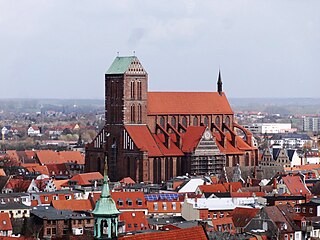
Wismar, officially the Hanseatic City of Wismar is, with around 43,000 inhabitants, the sixth-largest city of the northeastern German state of Mecklenburg-Vorpommern, and the fourth-largest city of Mecklenburg after Rostock, Schwerin and Neubrandenburg. The city was the third-largest port city in former East Germany after Rostock and Stralsund.

Johann Cochlaeus (Cochläus) was a German humanist, music theorist, and controversialist.

Olof Persson, sometimes Petersson, better known under the Latin form of his name, Olaus Petri, was a clergyman, writer, judge, and major contributor to the Protestant Reformation in Sweden. His brother, Laurentius Petri, became the first Evangelical Lutheran Archbishop of Sweden.

Erik Gustaf Geijer was a Swedish writer, historian, poet, romantic critic of political economy, philosopher, and composer. His writings served to promote Swedish National Romanticism. He was an influential advocate of Liberalism.
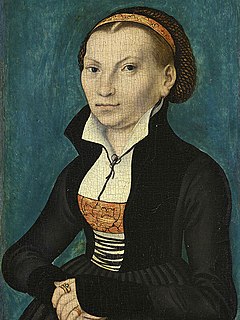
Katharina von Bora, after her wedding Katharina Luther, also referred to as "die Lutherin", was the wife of Martin Luther, German reformer and a seminal figure of the Protestant Reformation. Beyond what is found in the writings of Luther and some of his contemporaries, little is known about her. Despite this, Katharina is often considered one of the most important participants in the Reformation because of her role in helping to define Protestant family life and setting the tone for clergy marriages.
Crypto-Calvinism is a pejorative term describing a segment of German members of the Lutheran Church accused of secretly subscribing to Calvinist doctrine of the Eucharist in the decades immediately after the death of Martin Luther in 1546.
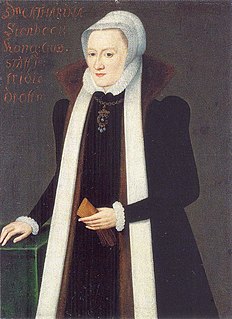
Catherine Stenbock was Queen of Sweden from 1552 to 1560 as the third and last wife of King Gustav I.

The Archbishop of Uppsala has been the primate of Sweden in an unbroken succession since 1164, first during the Catholic era, and from the 1530s and onward under the Lutheran church.

Erik Acharius was a Swedish botanist who pioneered the taxonomy of lichens and is known as the "father of lichenology." Acharius was famously the last pupil of Carl Linnaeus.

Johan Carl Wilcke was a Swedish physicist.

Under the Sun is a Swedish film which was released to cinemas in Sweden on 25 December 1998, directed by Colin Nutley, adapted from the short story The Little Farm by H. E. Bates. The film stars Rolf Lassgård, Helena Bergstrom, and Johan Widerberg. Set in Sweden in the mid-1950s, the film was nominated for the 1999 Academy Award for Best Foreign Language Film.

The Reformation in Denmark–Norway and Holstein was the transition from Catholicism to Lutheranism in the realms ruled by the Danish-based House of Oldenburg in the first half of the sixteenth century. After the break-up of the Kalmar Union in 1521/1523, these realms included the kingdoms of Denmark and Norway and the Duchies of Schleswig and Holstein, whereby Denmark also extended over today's Gotland and Øsel in Estonia.
Martha Eriksdotter Leijonhufvud, known as Kung Märta, was a politically-active Swedish noblewoman. She was the sister of Queen Margaret Leijonhufvud and sister-in-law of King Gustav I of Sweden: she was also the maternal aunt of Queen Catherine Stenbock and the daughter-in-law of the regent Christina Gyllenstierna. In 1568, she financed the deposition of King Eric XIV of Sweden, which placed her nephew John III of Sweden on the throne.
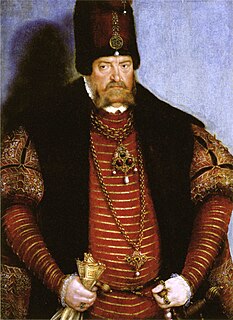
Joachim II was a Prince-elector of the Margraviate of Brandenburg (1535–1571), the sixth member of the House of Hohenzollern. Joachim II was the eldest son of Joachim I Nestor, Elector of Brandenburg and his wife Elizabeth of Denmark, Norway, and Sweden. He received the cognomen Hector after the Trojan prince and warrior for his athel qualities and prowess.

Franciscus Pahr was an Italian architect who worked in Silesia and Sweden from the 1550s. He is remembered above all for his work in Uppsala where he contributed to the cathedral and castle. He refurbished the Upsala castle completely after the fire of 1572. Pahr was from a family of architects who worked in Germany and Sweden during the later part of 16th century and were instrumental in introducing Renaissance architecture to northern Europe. One of the first projects in this genre in Germany was Pahr's work at Uppsala.
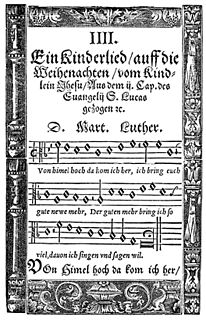
"Vom Himmel hoch, da komm ich her" is a hymn text relating to the Nativity of Jesus, written by Martin Luther in 1534. The hymn is most often sung to the melody, Zahn No. 346, which first appeared in a 1539 songbook and was probably also composed by Luther. This classic Christmas carol remains popular and has inspired many choral and organ works by other composers.
Margareta Brahe was a Swedish courtier; hovmästarinna to princess Anna Vasa of Sweden, from 1591.

Lars Lönnroth is a Swedish literary scholar.
References
- ↑ "Georgius Norman (1524 Ost.) @ Rostocker Matrikelportal". matrikel.uni-rostock.de. Retrieved 2022-04-26.